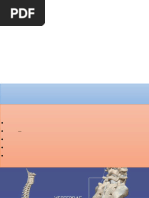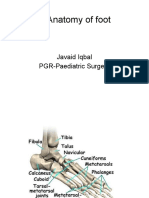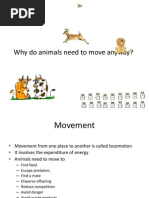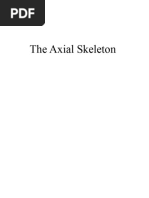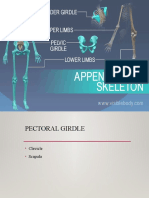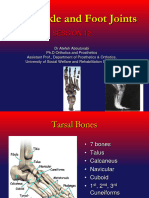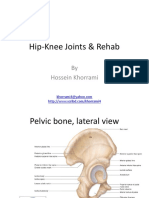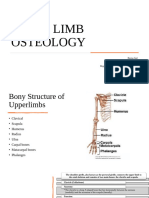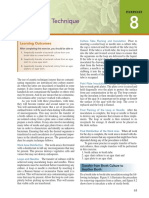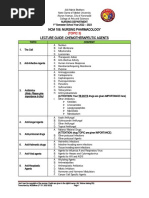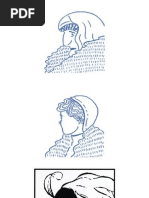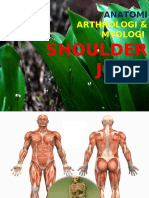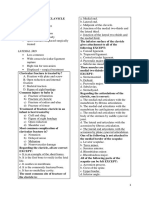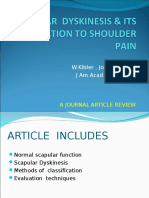0 ratings0% found this document useful (0 votes)
18 viewsSkeletal System Shoulder and Arm PPT
Skeletal System Shoulder and Arm PPT
Uploaded by
Insatiable CleeThe skeletal system includes the shoulder girdle, arm, hip, and leg bones. The shoulder girdle consists of the scapula and clavicle and attaches the arms. The humerus forms the ball-and-socket shoulder joint and hinge elbow joint. The forearm bones are the radius and ulna. The hip bones form the pelvic girdle and ball-and-socket hip joints with the femurs. Below the knee are the tibia, fibula, tarsals, and phalanges of the foot.
Copyright:
© All Rights Reserved
Available Formats
Download as PDF, TXT or read online from Scribd
Skeletal System Shoulder and Arm PPT
Skeletal System Shoulder and Arm PPT
Uploaded by
Insatiable Clee0 ratings0% found this document useful (0 votes)
18 views23 pagesThe skeletal system includes the shoulder girdle, arm, hip, and leg bones. The shoulder girdle consists of the scapula and clavicle and attaches the arms. The humerus forms the ball-and-socket shoulder joint and hinge elbow joint. The forearm bones are the radius and ulna. The hip bones form the pelvic girdle and ball-and-socket hip joints with the femurs. Below the knee are the tibia, fibula, tarsals, and phalanges of the foot.
Original Title
Skeletal+System+Shoulder+and+Arm+PPT
Copyright
© © All Rights Reserved
Available Formats
PDF, TXT or read online from Scribd
Share this document
Did you find this document useful?
Is this content inappropriate?
The skeletal system includes the shoulder girdle, arm, hip, and leg bones. The shoulder girdle consists of the scapula and clavicle and attaches the arms. The humerus forms the ball-and-socket shoulder joint and hinge elbow joint. The forearm bones are the radius and ulna. The hip bones form the pelvic girdle and ball-and-socket hip joints with the femurs. Below the knee are the tibia, fibula, tarsals, and phalanges of the foot.
Copyright:
© All Rights Reserved
Available Formats
Download as PDF, TXT or read online from Scribd
Download as pdf or txt
0 ratings0% found this document useful (0 votes)
18 views23 pagesSkeletal System Shoulder and Arm PPT
Skeletal System Shoulder and Arm PPT
Uploaded by
Insatiable CleeThe skeletal system includes the shoulder girdle, arm, hip, and leg bones. The shoulder girdle consists of the scapula and clavicle and attaches the arms. The humerus forms the ball-and-socket shoulder joint and hinge elbow joint. The forearm bones are the radius and ulna. The hip bones form the pelvic girdle and ball-and-socket hip joints with the femurs. Below the knee are the tibia, fibula, tarsals, and phalanges of the foot.
Copyright:
© All Rights Reserved
Available Formats
Download as PDF, TXT or read online from Scribd
Download as pdf or txt
You are on page 1of 23
Human Skeletal System
SHOULDER, ARM, HIP & LEG
Shoulder Girdles
• Attach the arms to the axial
skeleton
• Each consists of a scapula
(shoulder blade) and
clavicle (collarbone)
Scapula
• A large, flat bone with several
projections
• The spine of the scapula, the
coracoid process
• Anchor some of the muscles
that move up the upper and the
forearm
Clavicle
• Each clavicle articulates laterally with a scapula and medially
with the manubrium of the sternum
• In this position the clavicle act as braces for the scapulae and prevent
the shoulders from coming too far forward
• Although the shoulder joint is capable of a wide range of
movement, the shoulder itself must be relatively stable if these
movements are to be effective
Humerus
• The long bone of the upper
arm
• The triangular deltoid muscle
that caps the shoulder joint is
anchored in the deltoid
tubercle
Humerus
• Proximally, the humerus forms a ball-
and-socket joint with the scapula
• Distally, the humerus forms a hinge
joint with the ulna of the forearm
• This hinge joint, the elbow, permits
movement in one plane
• That is, back and forth with no lateral
movement
Radius and Ulna
• The forearm bones are the ulna on the
little finger side and the radius on the
thumb side
• The semilunar notch of the ulna is part
of the hinge joint of the elbow
• It articulates with the trochlea of the
humerus
Radius and Ulna
• The radius and ulna articulate
proximally to form a pivot joint
• This permits turning the hand palm up to
palm down
• The radius crosses over the ulna
• This permits the hand to perform a great
variety of movements without moving the
entire arm
Hand
• Eight small bones in the wrist
• Gliding joints between them permit a
sliding movement
• Also articulate with the distal ends of
the ulna and radius and with the
proximal ends of the metacarpals
• Metacarpals: Five bones of the palm
of the hand
Phalanges
• Bones of the fingers
• There are two phalanges in
each thumb and three in each
of the fingers
Hip bones
• The pelvic girdle or pelvic bone
consists of the two hip bones
(coxae or innominate bones)
• Articulate with the axial skeleton
at the sacrum
• Each hip bone has three major
parts:
• Ilium, ischium and pubis
Hip bones
• Ilium: The flared, upper portion
that forms the sacroiliac joint
• Ischium: lower, posterior part
that we sit on
• Pubis: lower most anterior part
Pubic bones
• The 2 pubic bones articulate
with one another at the pubic
symphysis, with a disc of
fibrous cartilage between them
Acetabulum
• The socket in the hip bone that
forms a ball-and-socket joint with
the femur
• This socket is deep because the hip is
a weight-bearing joint
• The depth of the acetabulum allows
the hip joint to not be dislocated
easily even by stressful activities
Femur
• The long bone of the thigh
• Forms a very movable ball-
and-socket joint with the
hip bone
Femur
• At the proximal end of the femur
are the greater and lesser
trochanters
• These are large projections that
are anchors for muscles
• At its distal end, the femur forms
a hinge joint, the knee with the
tibia of the lower leg
Patella
• Also called kneecap
• Is anterior to the knee joint, enclosed
in the tendon of the quadriceps
femoris, a large muscle group of the
thigh
Tibia
• Is the weight-bearing bone
lower legs
• A tibial tuberosity and an
anterior crest can be felt on the
front of the leg
Fibula
• Not a weight-bearing bone
but anchors leg muscles and
helps stabilize the ankle
Tarsals
• Seven bones in the ankle
• Larger and stronger than
carpals of the wrist
• Their gliding joints do not provide
nearly as much movement
Foot
• Calcaneus: heel bone
• Talus: transmits weight between the
calcaneus and the tibia
• Metatarsals: five long bones of each
foot
• Phalanges: bones of the toes
Phalanges
• There are two phalanges in the big toe
and three in each of the other toes
• Form hinge joints with each other
• Because there is no saddle joint in the
foot, the big toe is not as movable as the
thumb
Foot
• The foot has two major arches:
longitudinal and transverse
• Supported by ligaments
• These are adaptations for walking
completely upright
You might also like
- Neanderthal No MoreDocument87 pagesNeanderthal No MoreaskofsublimeNo ratings yet
- Pressure Pointer ManualDocument17 pagesPressure Pointer ManualsorinmoroNo ratings yet
- GMB Flexibility Resource Guide PDFDocument41 pagesGMB Flexibility Resource Guide PDFdundovicdavor9No ratings yet
- World Health Organization - WHO Standard Accupuncture Point LocationsDocument249 pagesWorld Health Organization - WHO Standard Accupuncture Point LocationsMirjana Adzic100% (2)
- Human Skeletal System PPTDocument73 pagesHuman Skeletal System PPTInsatiable CleeNo ratings yet
- Appendicular SkeletonDocument58 pagesAppendicular Skeletonziya4hmad.9258No ratings yet
- Class III Lower LimbDocument82 pagesClass III Lower LimbAyana UrmaleNo ratings yet
- Lab 4Document17 pagesLab 4hussen.518057No ratings yet
- Chapter 7 B Appendicular SkeletonDocument46 pagesChapter 7 B Appendicular SkeletonGabz Gabby100% (2)
- Skeletal SystemDocument54 pagesSkeletal Systemanurag.dNo ratings yet
- Bones of The Upper Limb and OssificationDocument43 pagesBones of The Upper Limb and OssificationJoshuaNo ratings yet
- Bones of Limbs - Pharmacy - 12-9Document41 pagesBones of Limbs - Pharmacy - 12-9安 娜 胡No ratings yet
- Human SkeletonDocument30 pagesHuman Skeletonrsithole2006No ratings yet
- Anatomy of Foot: Javaid Iqbal PGR-Paediatric SurgeryDocument36 pagesAnatomy of Foot: Javaid Iqbal PGR-Paediatric SurgeryJavaid KhanNo ratings yet
- Foot AnatomyDocument85 pagesFoot Anatomykeerthan.tpkj.2005No ratings yet
- Summary Note on the Upper Limb.docxDocument24 pagesSummary Note on the Upper Limb.docxbezles12345No ratings yet
- Osteology of The Upper ExtremityDocument75 pagesOsteology of The Upper ExtremityKevo YoungNo ratings yet
- Skeletal System Vertebra and Ribs PPTDocument18 pagesSkeletal System Vertebra and Ribs PPTInsatiable CleeNo ratings yet
- The Appendicular SkeletonDocument12 pagesThe Appendicular SkeletonWani SweetnessmilkyteaNo ratings yet
- Skeletal-SystemDocument28 pagesSkeletal-SystemRaiza Abegail RoxasNo ratings yet
- Appendicular Skeleton and FracturesDocument33 pagesAppendicular Skeleton and FracturesMaisNo ratings yet
- Why Do Animals Need To Move Anyway?Document42 pagesWhy Do Animals Need To Move Anyway?genngillNo ratings yet
- my skeleton system.pdfDocument63 pagesmy skeleton system.pdfpratiharyminakshi1976No ratings yet
- Anatomi 1.2 Skeleton AxialDocument45 pagesAnatomi 1.2 Skeleton Axialaqilah15noveraNo ratings yet
- Osteology of Pelvis and Femur - FinalDocument30 pagesOsteology of Pelvis and Femur - Finalbhavikaagarwal07No ratings yet
- Bones of The Lower Limbs2 3 FINALLYDocument26 pagesBones of The Lower Limbs2 3 FINALLYolamidealapa2608No ratings yet
- Ankle Foot BiomechanicsDocument38 pagesAnkle Foot BiomechanicsAnish BishwakarmaNo ratings yet
- 13.0 Lower Limb MusclesDocument124 pages13.0 Lower Limb MusclesAisyah ZainoriNo ratings yet
- Bones of Lower LimbsDocument11 pagesBones of Lower Limbsbasitali khanNo ratings yet
- Skeletal SystemDocument12 pagesSkeletal SystemAroosh ChaudhryNo ratings yet
- THELEGDocument42 pagesTHELEGMeke KaaleNo ratings yet
- Appendicular SkeletonDocument27 pagesAppendicular SkeletonSheena SapaoNo ratings yet
- 3.3 JOINTSDocument58 pages3.3 JOINTS2022879878No ratings yet
- Skeletal System Appendicular SkeletonDocument34 pagesSkeletal System Appendicular SkeletonEDWIN MUSUKWANo ratings yet
- Ankle and foot anatomyDocument70 pagesAnkle and foot anatomyjvcastroNo ratings yet
- Shoulder SlidesDocument84 pagesShoulder SlidesSean Joseph100% (1)
- L8-Topographical Anatomy of The Upper Limbs - CompressedDocument72 pagesL8-Topographical Anatomy of The Upper Limbs - Compressedmosesasante432No ratings yet
- Anatomy of The Lower Limb: by Dr. G. TowoDocument146 pagesAnatomy of The Lower Limb: by Dr. G. TowoVuluwa GeorgeNo ratings yet
- Powerpoint (1)Document22 pagesPowerpoint (1)imkongnukshi210No ratings yet
- anatomy_lecture-7Document38 pagesanatomy_lecture-7dcrehabserviceNo ratings yet
- Skeletal SystemDocument32 pagesSkeletal SystemMatthew Hall100% (1)
- Bones of The UpperlimbDocument57 pagesBones of The Upperlimbrayprincely7No ratings yet
- ANA212 - Oesteology of Lower Limbs 2020Document52 pagesANA212 - Oesteology of Lower Limbs 2020osunmuyiwaaNo ratings yet
- Session12 - Foot and Ankle BiomechanicsDocument33 pagesSession12 - Foot and Ankle Biomechanicsbirijik7979No ratings yet
- Appendicular Skeleton: Upper Lower Limbs GirdlesDocument37 pagesAppendicular Skeleton: Upper Lower Limbs GirdlesAprilSensengNo ratings yet
- Ana2213(Lower Limbs Osteology)(1)Document64 pagesAna2213(Lower Limbs Osteology)(1)yakubyakson43No ratings yet
- Osseous SystemDocument101 pagesOsseous Systemarpitsonone16No ratings yet
- Skeletal System PT 2Document70 pagesSkeletal System PT 2Shared AccountNo ratings yet
- Arches of FootDocument17 pagesArches of FootNupoor AhujaNo ratings yet
- Pelvic, Hip-Knee Joints & RehabDocument110 pagesPelvic, Hip-Knee Joints & Rehabkhorrami4100% (2)
- Kulpak DMS 2 2020Document31 pagesKulpak DMS 2 2020Ester ManurungNo ratings yet
- Lab. 7Document27 pagesLab. 7hudhyfa1No ratings yet
- 06 Skeletal System Notes PDFDocument12 pages06 Skeletal System Notes PDFshjsjNo ratings yet
- HindlimbDocument60 pagesHindlimbsaikotbau56121No ratings yet
- Axial Skeleton (Part 2)Document22 pagesAxial Skeleton (Part 2)HamnaNo ratings yet
- Anatomy of Hip and Knee Joint and Popliteal Fossa: Prof. Dr. Nabil KhourDocument49 pagesAnatomy of Hip and Knee Joint and Popliteal Fossa: Prof. Dr. Nabil KhourBadria Al-najiNo ratings yet
- Lower Limb BONESDocument79 pagesLower Limb BONESDr.Kumar Satish Ravi100% (1)
- ACHILLES UPPER LIMB SLIDE(DEAN) (1)Document43 pagesACHILLES UPPER LIMB SLIDE(DEAN) (1)mayowasanni47No ratings yet
- The Skeletal SystemDocument9 pagesThe Skeletal SystemMariadas RajamaniNo ratings yet
- 10-Upper Limb OsteologyDocument16 pages10-Upper Limb Osteologymudassarhussain9456645No ratings yet
- 4.2 Human Anatomy and Physiology Basics-of-Skeletal-SystemDocument81 pages4.2 Human Anatomy and Physiology Basics-of-Skeletal-SystemNora MajabaNo ratings yet
- Skeletal SystemDocument82 pagesSkeletal SystemJexine YsabelleNo ratings yet
- Healthy Hips Handbook: Exercises for Treating and Preventing Common Hip Joint InjuriesFrom EverandHealthy Hips Handbook: Exercises for Treating and Preventing Common Hip Joint InjuriesNo ratings yet
- GREEN-UNIVERSITY-POLICY-Presentation 20240809 145818 0000Document60 pagesGREEN-UNIVERSITY-POLICY-Presentation 20240809 145818 0000Insatiable CleeNo ratings yet
- Socsci 143 Week 2Document28 pagesSocsci 143 Week 2Insatiable CleeNo ratings yet
- Socsci 143 Week 1Document44 pagesSocsci 143 Week 1Insatiable CleeNo ratings yet
- 117 LESSON 3 PresentationDocument89 pages117 LESSON 3 PresentationInsatiable CleeNo ratings yet
- 7 Human Population GrowthDocument99 pages7 Human Population GrowthInsatiable CleeNo ratings yet
- 117 LESSON 3.coursepackDocument6 pages117 LESSON 3.coursepackInsatiable CleeNo ratings yet
- Narito Ang Pangkat NG Mga Wika Sa PilipinasDocument10 pagesNarito Ang Pangkat NG Mga Wika Sa PilipinasInsatiable CleeNo ratings yet
- DM Lecture Part 2Document102 pagesDM Lecture Part 2Insatiable CleeNo ratings yet
- Ahe Lesson 1Document35 pagesAhe Lesson 1Insatiable CleeNo ratings yet
- M2 THE CREED Introduction and Articles PDFDocument8 pagesM2 THE CREED Introduction and Articles PDFInsatiable CleeNo ratings yet
- Name: Dacumos, Cyrus Lee M. Date: May 10, 2022 Year and Section: 1st Year BSN - 1ADocument3 pagesName: Dacumos, Cyrus Lee M. Date: May 10, 2022 Year and Section: 1st Year BSN - 1AInsatiable CleeNo ratings yet
- Ahe Reviewer Lesson 2 YuhDocument5 pagesAhe Reviewer Lesson 2 YuhInsatiable CleeNo ratings yet
- Assisting Handling Delivery LecturetteDocument4 pagesAssisting Handling Delivery LecturetteInsatiable CleeNo ratings yet
- Diagnosis of Parasitic InfectionsDocument22 pagesDiagnosis of Parasitic InfectionsInsatiable CleeNo ratings yet
- Partial Hydatidiform Mole: Notre Dame of Marbel UniversityDocument127 pagesPartial Hydatidiform Mole: Notre Dame of Marbel UniversityInsatiable CleeNo ratings yet
- Cestodes Lab ManualDocument5 pagesCestodes Lab ManualInsatiable CleeNo ratings yet
- CH 01 Lecture Presentation PCDocument58 pagesCH 01 Lecture Presentation PCInsatiable CleeNo ratings yet
- Pure Culture TechniqueLab. Manual in Gen. Micro. 2015Document12 pagesPure Culture TechniqueLab. Manual in Gen. Micro. 2015Insatiable CleeNo ratings yet
- Protozoa Post LabDocument3 pagesProtozoa Post LabInsatiable CleeNo ratings yet
- Aseptic TechniqueLab. Manual in Gen. Micro. 2015Document10 pagesAseptic TechniqueLab. Manual in Gen. Micro. 2015Insatiable CleeNo ratings yet
- Culturing MicroorganismsDocument26 pagesCulturing MicroorganismsInsatiable CleeNo ratings yet
- Lecturette 3Document2 pagesLecturette 3Insatiable CleeNo ratings yet
- Sample Lab ReportDocument3 pagesSample Lab ReportInsatiable CleeNo ratings yet
- Lecturette 2Document14 pagesLecturette 2Insatiable CleeNo ratings yet
- Drug CalculationDocument58 pagesDrug CalculationInsatiable CleeNo ratings yet
- Post-Lab TrematodesDocument4 pagesPost-Lab TrematodesInsatiable CleeNo ratings yet
- Skeletal System Vertebra and Ribs PPTDocument18 pagesSkeletal System Vertebra and Ribs PPTInsatiable CleeNo ratings yet
- Lesson 1Document35 pagesLesson 1Insatiable CleeNo ratings yet
- Lesson 2Document37 pagesLesson 2Insatiable CleeNo ratings yet
- Lesson 2Document37 pagesLesson 2Insatiable CleeNo ratings yet
- The Back Squat Targeted Training Techniques To.2Document48 pagesThe Back Squat Targeted Training Techniques To.2Oscar Björk100% (1)
- Or6 st3 PDFDocument4 pagesOr6 st3 PDFerajNo ratings yet
- Anatomy and Sonoanatomy of The Shoulder: (See Fig. 4-1A and B)Document12 pagesAnatomy and Sonoanatomy of The Shoulder: (See Fig. 4-1A and B)Apollo MailNo ratings yet
- Axilla and Brachial PlexusDocument67 pagesAxilla and Brachial PlexusAuza Moses IbrahimNo ratings yet
- The Skeletal SystemDocument10 pagesThe Skeletal SystemJessa Mae BanquirigNo ratings yet
- Shoulder - Complex - PDF - 2023 12 07 - 05 53 55Document4 pagesShoulder - Complex - PDF - 2023 12 07 - 05 53 55726mkdztdtNo ratings yet
- Upper Ex OINADocument15 pagesUpper Ex OINAChristi EspinosaNo ratings yet
- Anatomy Chapters 6&7Document17 pagesAnatomy Chapters 6&7Tamara IdalyNo ratings yet
- Anaphy CompilationDocument32 pagesAnaphy Compilationismael celociaNo ratings yet
- ANATOMI Art & Myo Bahu-2Document12 pagesANATOMI Art & Myo Bahu-2Lola Kholas Rub'ahNo ratings yet
- Turkey Meat StandardDocument24 pagesTurkey Meat StandardoptimeatvaleriaNo ratings yet
- 10 Deadlift Cues For Stronger PullsDocument17 pages10 Deadlift Cues For Stronger PullsAlejandro Herrnsdorf-SakellaridisNo ratings yet
- 8 - Opposite Position LoadingDocument21 pages8 - Opposite Position Loadingbreinfout fotosNo ratings yet
- Shoulder StabilityDocument5 pagesShoulder StabilityAshley WatsonNo ratings yet
- Rotator Cuff Shoulder Rehabilitation: Abdirashid Hassan Kassim Shirwa Abdihabib AbdulleDocument19 pagesRotator Cuff Shoulder Rehabilitation: Abdirashid Hassan Kassim Shirwa Abdihabib AbdulleVictoria Chihai100% (1)
- Crtical Inquiry Questions On BNPN2013 .Document15 pagesCrtical Inquiry Questions On BNPN2013 .gaisek garguyaNo ratings yet
- Selective Anatomy Prep Manual For Undergraduates Vol 1 2e 1 2nbspedDocument524 pagesSelective Anatomy Prep Manual For Undergraduates Vol 1 2e 1 2nbspedDevyan RaiNo ratings yet
- Volume 1, BD Chaurasia Human Anatomy, Upper Limb and Thorax-SplitDocument20 pagesVolume 1, BD Chaurasia Human Anatomy, Upper Limb and Thorax-Splitprashant6388kumarNo ratings yet
- Ketos AJA2003Document42 pagesKetos AJA2003kavvadiusNo ratings yet
- Fractures of The Upper LimbDocument3 pagesFractures of The Upper LimbJim Jose AntonyNo ratings yet
- Challoumas 2016Document19 pagesChalloumas 2016boubekri.yaakoubNo ratings yet
- Biomechanics of ShoulderDocument68 pagesBiomechanics of ShoulderLedy Kumala DeviNo ratings yet
- 3-Pectoral RegionDocument39 pages3-Pectoral Regionsama rasmyNo ratings yet
- Scapula - Elevation and DepressionDocument16 pagesScapula - Elevation and DepressiondulexNo ratings yet
- A Guide To Work With ComputersDocument20 pagesA Guide To Work With ComputersdonbabaNo ratings yet
- Scapular Dyskinesis Its Relation To Shoulder PainDocument21 pagesScapular Dyskinesis Its Relation To Shoulder PainTamas KalmarNo ratings yet





